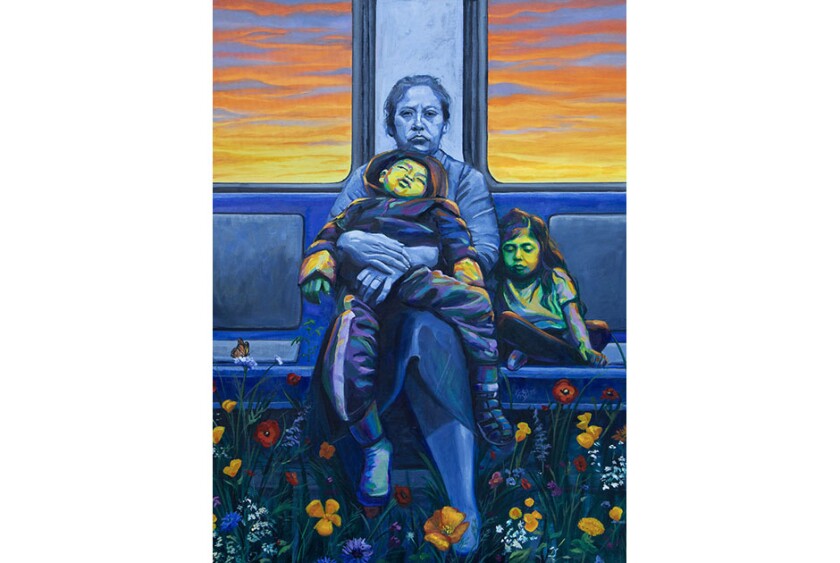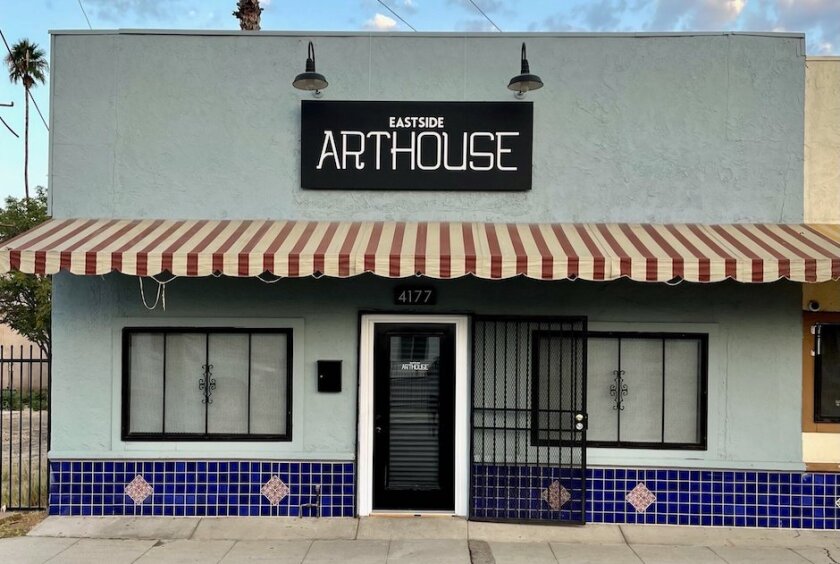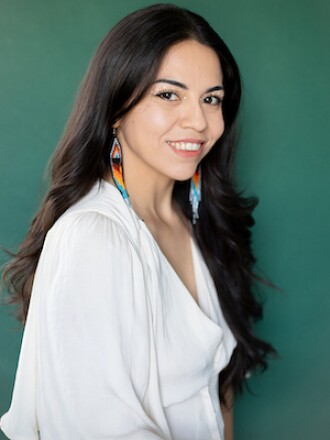“I didn’t think they had value, but strangers began to message me telling me not to give them away, that I had talent,” she says. “A woman who had worked at an art gallery begged me to keep painting — that was very motivating.”
Today, Cortez has a painting in the community gallery at the Cheech Marin Center for Chicano Art and Culture (“The Cheech”) and a waiting list for her work. She didn’t have to leave her hometown of Riverside for New York or Los Angeles for any of this to happen.
Opened this year, The Cheech has brought national and international attention to Riverside, a city of 314,000 located about 50 miles southeast of Los Angeles. Its collection of works created by American artists of Mexican descent, the largest in the world, is built around more than 500 pieces gifted by Cheech Marin, an actor, writer, producer and humanitarian whose appeal cuts across generations. He is regarded as the preeminent collector of Chicano art.
“My motto has always been that you can’t love or hate Chicano art unless you see it,” Marin said at the museum’s June opening. “Now people will have a place to always see it. This is such a happy and humbling moment for me.”
According to Pew Research analysis, in 2021 nearly six in 10 Latinos in the U.S. were of Mexican descent, as are 84 percent in California. There are more Hispanic citizens in California than the entire population of every state but four, and at 54 percent, their share of the Riverside population is greater than the state average.
“People have been blown away by coming into a really wonderful center and seeing stories that reflect their history on the walls,” says Maria Esther Fernandez, the artistic director of The Cheech. “That's something you don’t typically see in mainstream institutions.”
Demographics are not the only reason it may have been inevitable that Riverside would host The Cheech. For years, the community has fostered a merging of art, equity and community development.

(Rosy Cortez)
Reading the Audience
Fernandez came to The Cheech from the Bay Area, and as she got to know Riverside, she was struck by the level of community support for the arts. This is evidenced in the fact that The Cheech came into existence within five years of its conception, even though fundraising and construction took place during the pandemic.
In 2017, the Riverside Art Museum (RAM) hosted an exhibit of some of the work Marin had collected. The exhibit was a huge hit, recalls Riverside Mayor Patricia Lock Dawson. “It tapped into something in Riverside’s population — they loved it,” she says. “People were lined up around the block.”
The city owned a library building in the center of town that was slated for repurposing, and it proposed a partnership between the city, RAM and Marin to use it to create a permanent home for his collection and works by other Chicano artists.
The direct construction budget for renovating 40,000 square feet in the city-owned building was about $10.7 million, says RAM’s executive director, Drew Oberjuerge, much less than the usual price tag for a museum of its size. “It was a really creative way to leverage our resources and do something special in a relatively short period of time,” she says.
The funds to make this possible came from sources ranging from private donors to families and car clubs, Fernandez says. “Unidos, a group of community members from all walks of life, came together to lead the capital campaign.”
RAM had been building strong relationships ever since the Riverside Art Association was founded in the 1950s by a group of local artists. The group’s first home was at an abandoned dog pound leased from the city for $1 a year, but by 1967 it was able to purchase a former YMCA facility designed by the renowned California architect Julia Morgan.
RAM hasn’t limited its emphasis on art to what sits inside its building (which is now on the National Register of Historic Places). One of the first opportunities Rosy Cortez had to bring her art to the public was by participating in a project intended to bring beauty to underserved parts of her city.

(Juan Navarro)
Art as Social Work
Growing up in Riverside, Juan Navarro, artist in residence for RAM, envisioned a career as a social worker. Early in his college career he even earned an associate degree in social behavioral studies. “But then someone stopped me in my tracks and said, 'Juan, you're too much of an artist to pursue that.'”
Navarro built a following by sharing his work online and spent time in Los Angeles and Northern California in an effort to solve the mystery of what it takes to make a living as an artist. After he returned to Riverside a friend helped him connect with the Riverside Community Health Foundation, where he became involved in a community-based murals project.
“The grant was one to beautify alleys, to use murals to discourage illegal activity, make things feel safer and engage youth in the transformation,” Navarro recalls. This led to mural projects with other community-based organizations and the beginning of a relationship with RAM. (He’s been their artist in residence for the past five years.)
Cortez was busy as well. She quit her job at a photography studio and managed to secure an artist-in-residency fellowship at the University of California Riverside Latino and Latin American Studies Research Center. In 2021, RAM selected her as an emerging artist to collaborate with Navarro on a storefront revitalization project in the city’s Eastside neighborhood.
The process of creating these works is as important to their success as the quality of the art, Navarro says. Members of the community are informed about planned murals and are asked what kinds of images would represent the things that matter to them. Community members are invited to participate in the painting.
The murals have had a big impact, says Cortez. “People have come to our mural sites saying thank you for doing this, because nobody cares about our little hood.” Knowing that these works will bring visitors to their community, residents have organized cleanups.
In turn, the morale of the artists is boosted by the fact that the mayor and the city are backing this kind of work, along with art walks and live painting demonstrations. “We’re constantly giving back because we feel like the city cares about us and cares about our art,” says Cortez. “It just uplifts everything.”
Whether it was known to anyone outside Riverside or not, when The Cheech opened its doors, the city already had an art scene built on inclusion and diversity.

(Riverside Art Museum)
All Boats Rising
The Cheech has enabled the RAM to fulfill its mission in ways that have exceeded its expectations. More than 50,000 people have visited since it opened four months ago. The opening has been covered by national and international press, an uncommon occurrence in a city that does not have high-profile media outlets of its own.
“It’s been a very emotional response for a lot of people who have perhaps not been welcomed into the art world, or seen elements of their cultures represented in art,” says Mayor Dawson. “There are so many things that reflect struggles and parts of history in ways that the population has never seen before.”
The museum’s notoriety has made it a sought-after meeting place. In the weeks since its opening, it has hosted the Irvine Foundation, the Latino caucus from the California Legislature and the state’s association of economic developers as well as national groups.
“It’s been programmed pretty much every night,” says Dawson.
The Cheech is helping Riverside tell its story in ways that have not been possible in the past, and allowing visitors to discover more of what it has to offer. Oberjuerge encourages city planners and administrators to take a deeper look at the arts and their potential for civic engagement and community and economic development.
She also sees art as a much-needed civic resource that can help citizens think about people and communities outside of their own bubbles, without hitting them over the head. “One of my biggest concerns is that there’s not enough dialog about other people’s perspectives to move us forward.”
Fernandez sees an important role for mid-sized or regional museums at a time when cultural institutions are being called to be more reflective of the communities they serve. BIPOC (Black, Indigenous and people of color) communities have not been represented to an extent that reflects the contributions that they've made in the art world, or even to their own communities, she says.
“Art can drastically improve the quality of life in communities,” says Fernandez. “Art is healing; there’s so much research about what it does to a native child or an African American child to see themselves reflected in cultural institutions.”

(Juan Navarro)
Out of Hiding
Cortez and Navarro are both first-generation Mexican Americans, though they wouldn’t necessarily have thought about themselves as “Chicano” artists before The Cheech made such a splash in Riverside. Both agree that it’s important for others to see the world through the eyes of this community, independent of the style a particular artist might choose.

(Rosy Cortez)
When Fernandez is asked what “Chicano” art is, she declines to answer. “Art history is lagging in catching up in writing about the contributions of these amazingly gifted artists,” she says. One of her goals for The Cheech is to help further this work.
Navarro has his own approach to growing the movement. He’s converted an abandoned building to a co-working art studio, the Eastside Arthouse, to provide spaces for community artists who either have no place to work or prefer to work in an environment of creative colleagues. He’s also doing what he can to help them make a living through their art.
At present 15 artists are working at the Arthouse. Rosy Cortez was the first to get a piece in the community gallery at The Cheech but won’t be the last.
“There are so many talented people,” she says. “I had gone to school and moved back home, and I was just hiding in my room — I know there are more artists that are hiding too, in other communities that don’t have studios or a gallery or city-funded resources.”
That support, she says, has been everything.
Related Articles













